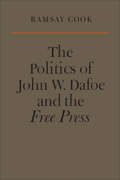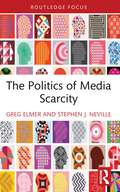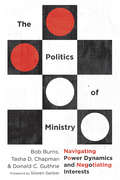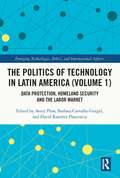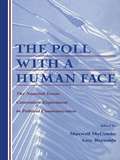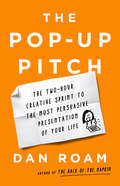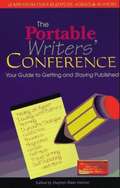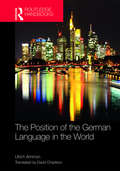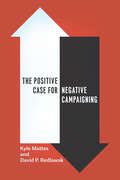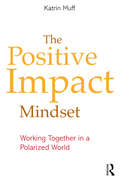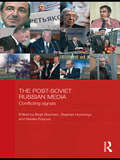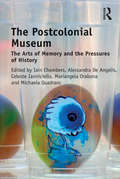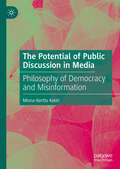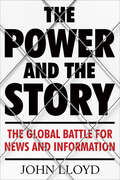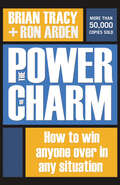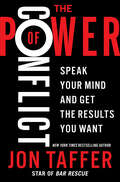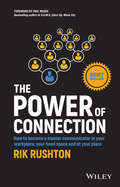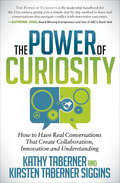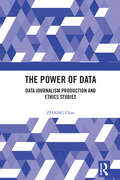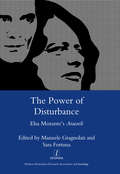- Table View
- List View
The Politics of John W. Dafoe and the Free Press
by Ramsay CookJohn W. Dafoe was a dominant figure in western Canadian political history during the first half of the twentieth century. As editor of the Winnipeg Free Press from 1901 to 1944, he gained an international reputation for his perceptive analysis of the issues facing Canada and the world. He was at the centre of almost every major political development of his time: he advised prime ministers, was deeply involved in organizing the Progressive party, and was a member of the crucial Rowell-Sirois Commission on federal-provincial relations. His influence was enormous, and at the time of his death he was widely regarded as the nation's most distinguished editor. This book is a study at close quarters of Dafoe, the man of politics. It focuses on the Dafoe who read and studied and the Dafoe who observed men and events; on Dafoe in his centre of operation and at the Free Press and Dafoe moving watchfully about the country and abroad when critical decisions were in the making; on the ideas confided in letters to friends and the ideas delivered in public speeches; on contributions made to conferences and commissions and advice given to political figures. The book is not intended as a complete biography of Dafoe in all his aspects, but it is even less an abstract treatise in the field of political theory. It is the biography of a political mind. The impression is of a mind recalled to its full vigour, for no prejudgments have been made about it and no restraints upon it. Ramsay Cook treats his subject with candour, but also with understanding and a sense of humour. He has ordered his material with extraordinary skill, so that his book is enjoyable reading as well as a valuable source of information about a distinguished Canadian and a momentous period in Canadian history.
The Politics of Media Scarcity (Routledge Focus on Media and Cultural Studies)
by Greg Elmer Stephen J. NevilleThis book questions the predominance of “media abundance” as a guiding concept for contemporary mediated politics. The authors argue that media abundance is not a universal condition, and that certain individuals, communities, and even nations can more accurately be referred to as media scarce – where access to media technologies and content is limited, highly controlled, or surveilled.Through case studies that focus on guerilla militants, incarcerated Indigenous people, and cold war‑era infrastructure, including Soviet “closed” or “secret” cities and Canadian nuclear bunkers, the book’s chapters interrogate how the once media scarce later “speak” to – and can be heard by – the predominant, abundant media culture. Drawing from several art projects and diverse cultural sites, the book highlights how media scarce communities negotiate and otherwise narrate their place in the world, their past experiences and lives, and escape from subjugation. To better understand media scarce politics, the book asks how and when communities become – by accident or force, by choice or necessity – media scarce.This innovative and insightful text will appeal to students and scholars around the world working in the areas of media and politics, art and politics, visual studies, surveillance studies, and communication studies.
The Politics of Ministry: Navigating Power Dynamics and Negotiating Interests
by Steven Garber Bob Burns Tasha D. Chapman Donald C. GuthrieWe all need help navigating the politics of ministry. "Politics" is often considered a dirty word. It brings to mind lies and manipulation, accusations and scandals. But at its most basic level, politics is simply the everyday activity of getting things done with other people: understanding their interests, recognizing the power dynamics at play, and learning how to negotiate relationships and institutions to achieve a common goal. These realities are as true in ministry settings as anywhere else. In The Politics of Ministry, Bob Burns, Tasha Chapman, and Donald Guthrie combine their long ministry experience with sociological research on the topic. Filled with real-life stories taken from a variety of ministry settings, this book sets out wise principles and practices that help us see more clearly the political dynamics at play in our churches and parachurch ministries. All ministry is political. As servants of Christ's kingdom, we are called to navigate the politics of ministry with grace, wisdom, and charity. This book shows us how the gospel of Jesus changes the way we work with those around us toward our common goal.
The Politics of Resentment: A Genealogy
by Jeremy EngelsIn the days and weeks following the tragic 2011 shooting of nineteen Arizonans, including congresswoman Gabrielle Giffords, there were a number of public discussions about the role that rhetoric might have played in this horrific event. In question was the use of violent and hateful rhetoric that has come to dominate American political discourse on television, on the radio, and at the podium. A number of more recent school shootings have given this debate a renewed sense of urgency, as have the continued use of violent metaphors in public address and the dishonorable state of America’s partisan gridlock. This conversation, unfortunately, has been complicated by a collective cultural numbness to violence. But that does not mean that fruitful conversations should not continue. In The Politics of Resentment, Jeremy Engels picks up this thread, examining the costs of violent political rhetoric for our society and the future of democracy.The Politics of Resentment traces the rise of especially violent rhetoric in American public discourse by investigating key events in American history. Engels analyzes how resentful rhetoric has long been used by public figures in order to achieve political ends. He goes on to show how a more devastating form of resentment started in the 1960s, dividing Americans on issues of structural inequalities and foreign policy. He discusses, for example, the rhetorical and political contexts that have made the mobilization of groups such as Nixon’s “silent majority” and the present Tea Party possible. Now, in an age of recession and sequestration, many Americans believe that they have been given a raw deal and experience feelings of injustice in reaction to events beyond individual control. With The Politics of Resentment, Engels wants to make these feelings of victimhood politically productive by challenging the toxic rhetoric that takes us there, by defusing it, and by enabling citizens to have the kinds of conversations we need to have in order to fight for life, liberty, and equality.
The Politics of Resentment: A Genealogy
by Jeremy EngelsIn the days and weeks following the tragic 2011 shooting of nineteen Arizonans, including congresswoman Gabrielle Giffords, there were a number of public discussions about the role that rhetoric might have played in this horrific event. In question was the use of violent and hateful rhetoric that has come to dominate American political discourse on television, on the radio, and at the podium. A number of more recent school shootings have given this debate a renewed sense of urgency, as have the continued use of violent metaphors in public address and the dishonorable state of America’s partisan gridlock. This conversation, unfortunately, has been complicated by a collective cultural numbness to violence. But that does not mean that fruitful conversations should not continue. In The Politics of Resentment, Jeremy Engels picks up this thread, examining the costs of violent political rhetoric for our society and the future of democracy.The Politics of Resentment traces the rise of especially violent rhetoric in American public discourse by investigating key events in American history. Engels analyzes how resentful rhetoric has long been used by public figures in order to achieve political ends. He goes on to show how a more devastating form of resentment started in the 1960s, dividing Americans on issues of structural inequalities and foreign policy. He discusses, for example, the rhetorical and political contexts that have made the mobilization of groups such as Nixon’s “silent majority” and the present Tea Party possible. Now, in an age of recession and sequestration, many Americans believe that they have been given a raw deal and experience feelings of injustice in reaction to events beyond individual control. With The Politics of Resentment, Engels wants to make these feelings of victimhood politically productive by challenging the toxic rhetoric that takes us there, by defusing it, and by enabling citizens to have the kinds of conversations we need to have in order to fight for life, liberty, and equality.
The Politics of Technology in Africa
by Iginio GagliardoneAs more Africans get online, information and communication technologies (ICTs) are increasingly hailed for their transformative potential. Yet, the fascination for the possibilities of promoting more inclusive forms of development in the information age have obfuscated the reality of the complex negotiations among political and economic actors who are seeking to use technology in their competition for power. Building on over ten years of research in Ethiopia, Iginio Gagliardone investigates the relationship between politics, development, and technological adoption in Africa's second most populous country and its largest recipient of development aid. The emphasis the book places on the 'technopolitics' of ICTs, and on their ability to embody and enact political goals, offers a strong and empirically grounded counter-argument to prevalent approaches to the study of technology and development that can be applied to other cases in Africa and beyond.
The Politics of Technology in Latin America: Data Protection, Homeland Security and the Labor Market (Emerging Technologies, Ethics and International Affairs)
by Avery Plaw David Ramírez Plascencia Barbara Carvalho GurgelThis book analyses the arrival of emerging and traditional information and technology for public and economic use in Latin America. It focuses on the governmental, economic and security issues and the study of the complex relationship between citizens and government. The book is divided into three parts: • ‘Digital data and privacy, prospects and barriers’ centers on the debates among the right of privacy and the loss of intimacy in the Internet, • ‘Homeland security and human rights’ focuses on how novel technologies such as drones and autonomous weapons systems reconfigure the strategies of police authorities and organized crime, • ‘Labor Markets, digital media and emerging technologies’ emphasize the legal, economic and social perils and challenges caused by the increased presence of social media, blockchain-based applications, artificial intelligence and automation technologies in the Latin American economy. This first volume in a two volume set will be important reading for scholars and students of governance in Latin American, the protection of human rights and the use of technology to combat crime and the new advances of digital economy in the region.
The Politics of Translation in International Relations (Palgrave Studies in International Relations)
by Zeynep Gulsah Capan Filipe Dos Reis Maj GrastenThis volume concerns the role and nature of translation in global politics. Through the establishment of trade routes, the encounter with the ‘New World’, and the circulation of concepts and norms across global space, meaning making and social connections have unfolded through practices of translating. While translation is core to international relations it has been relatively neglected in the discipline of International Relations. The Politics of Translation in International Relations remedies this neglect to suggest an understanding of translation that transcends language to encompass a broad range of recurrent social and political practices. The volume provides a wide variety of case studies, including financial regulation, gender training programs, and grassroot movements. Contributors situate the politics of translation in the theoretical and methodological landscape of International Relations, encompassing feminist theory, de- and post-colonial theory, hermeneutics, post-structuralism, critical constructivism, semiotics, conceptual history, actor-network theory and translation studies. The Politics of Translation in International Relations furthers and intensifies a cross-disciplinary dialogue on how translation makes international relations.
The Poll With A Human Face: The National Issues Convention Experiment in Political Communication (Routledge Communication Series)
by Amy Reynolds Maxwell McCombsIn 1996, the National Issues Convention (NIC) assembled a national sample of 459 Americans on the campus of the University of Texas at Austin. This diverse group of Americans was seen and heard nationally. They spent three days in small group discussions of major public issues and participated in two live PBS telecasts moderated by Jim Lehrer where they questioned Vice President Al Gore and four contenders for the Republican presidential nomination. This experiment in democracy was an innovative step that engaged the ongoing debate about mass communication and democracy. The Poll With a Human Face details this innovative event, the arguments and logic behind it, the experiences of the delegates and journalists involved in the NIC, and social science research analyzing the news coverage and its effects. This book is both a specific case study of the NIC and a broad scale contribution to the discipline of political communication.
The Pop-up Pitch: The Two-Hour Creative Sprint to the Most Persuasive Presentation of Your Life
by Dan RoamA fast and practical visual storytelling method that puts a powerful new toolkit into the hands of leaders, innovators, salespeople, teachers and anyone else who needs to quickly make an impact on increasingly distracted audiences.The Pop-Up Pitch is a radical new approach to help you create the perfect presentation, combining three key elements of persuasive storytelling-simple pictures, clear words, and powerful emotions-that together motivate audiences to pay attention, learn something new, and make effective decisions. The Pop-Up Pitch weaves together the latest insights on visual cognition, behavioral economics, and classic story structures in an easy-to-learn and inspiring storytelling algorithm. In this new era of remote, work and online presenting, it delivers powerful and persuasive outcomes for time-limited professionals dealing with complex ideas, attention-deficit audiences, and the evolving challenges of modern meetings.
The Portable Writers' Conference: Your Guide to Getting and Staying Published
by Stephen Blake MetteeIt's 8:24 a.m. on a rainy Ohio Saturday. Jamie Fergurson, attorney and mother of two, shakes the water from her umbrella, crosses the carpeted foyer to the eight-foot banquet table serving as a registration desk and joins the tens of thousands of writers and would-be writers who attend one of more than 400 writers' conferences held in the United States each year. Jamie will learn not only something of the craft of writing but alsoof such things as first serial rights, self-publishing, literary agents, query letters and royalties: the elements that constitute the business side of writing. These conferences, depending on venue, number of workshops, who the workshop leaders are and various other factors, traditionally cost anywhere form $65 to $3000. Now, however, Ms. Ferguerson can take advantage of one of the most comprehensive writers' conferences ever produced 47 workshops presented by a host of distinguished agents, authors and editors for less than $20. And this conference doesn't require travel time or expense; the workshops may be taken in any order she wants and she may repeat them again, in their entirety, whenever desired. That's because this writers' conference is a conference in a book: The Portable Writers' Conference: Your Guide to Getting and Staying Published, edited by Stephen Blake Mettee. The workshops are about evenly split between craft and business, fiction and nonfiction. Warner-Aspect Books' Editor-In-Chief Betsy Mitchell explains how to sell yourself in a query letter without offending the pro-spective editor. Literary agent Natasha Kern reveals how to find the right agent for you. Self-help book author Eric Maisel offers a twelve-step program for non-Ph.D's who want to write a self-help book. Suzanne Forster, recipient of Romantic Times Magazines's Career Achievement Award in Sensuality, tells how to write love scenes that sizzle. Novelist Marilyn Meredith shows how to turn your genealogy into fictional stories. Sara Ann Freed, executive editor, Mysterious Press, shares her seven secrets to creating memorable characters. Attorney-author John D. Zelezny deals with copyright. More than 45 chapters called workshops in the book provide instruction on the writing craft and the business of getting published.
The Position of the German Language in the World
by Ulrich AmmonThe Position of the German Language in the World focuses on the global position of German and the factors which work towards sustaining its use and utility for international communication. From the perspective of the global language constellation, the detailed data analysis of this substantial research project depicts German as an example of a second-rank language. The book also provides a model for analysis and description of international languages other than English. It offers a framework for strengthening the position of languages such as Arabic, Chinese, French, Portuguese, Spanish and others and for countering exaggerated claims about the global monopoly position of English. This comprehensive handbook of the state of the German language in the world was originally published in 2015 by Walter de Gruyter in German and has been critically acclaimed. Suitable for scholars and researchers of the German language, the handbook shows in detail how intricately and thoroughly German and other second-rank languages are tied up with a great number of societies and how these statistics support or weaken the languages’ functions and maintenance.
The Positive Case for Negative Campaigning
by Kyle Mattes David P. RedlawskTurn on the television or sign in to social media during election season and chances are you’ll see plenty of negative campaigning. For decades, conventional wisdom has held that Americans hate negativity in political advertising, and some have even argued that its pervasiveness in recent seasons has helped to drive down voter turnout. Arguing against this commonly held view, Kyle Mattes and David P. Redlawsk show not only that some negativity is accepted by voters as part of the political process, but that negative advertising is necessary to convey valuable information that would not otherwise be revealed. The most comprehensive treatment of negative campaigning to date, The Positive Case for Negative Campaigning uses models, surveys, and experiments to show that much of the seeming dislike of negative campaigning can be explained by the way survey questions have been worded. By failing to distinguish between baseless and credible attacks, surveys fail to capture differences in voters’ receptivity. Voters’ responses, the authors argue, vary greatly and can be better explained by the content and believability of the ads than by whether the ads are negative. Mattes and Redlawsk continue on to establish how voters make use of negative information and why it is necessary. Many voters are politically naïve and unlikely to make inferences about candidates’ positions or traits, so the ability of candidates to go on the attack and focus explicitly on information that would not otherwise be available is crucial to voter education.
The Positive Case for Negative Campaigning
by Kyle Mattes David P. RedlawskTurn on the television or sign in to social media during election season and chances are you’ll see plenty of negative campaigning. For decades, conventional wisdom has held that Americans hate negativity in political advertising, and some have even argued that its pervasiveness in recent seasons has helped to drive down voter turnout. Arguing against this commonly held view, Kyle Mattes and David P. Redlawsk show not only that some negativity is accepted by voters as part of the political process, but that negative advertising is necessary to convey valuable information that would not otherwise be revealed. The most comprehensive treatment of negative campaigning to date, The Positive Case for Negative Campaigning uses models, surveys, and experiments to show that much of the seeming dislike of negative campaigning can be explained by the way survey questions have been worded. By failing to distinguish between baseless and credible attacks, surveys fail to capture differences in voters’ receptivity. Voters’ responses, the authors argue, vary greatly and can be better explained by the content and believability of the ads than by whether the ads are negative. Mattes and Redlawsk continue on to establish how voters make use of negative information and why it is necessary. Many voters are politically naïve and unlikely to make inferences about candidates’ positions or traits, so the ability of candidates to go on the attack and focus explicitly on information that would not otherwise be available is crucial to voter education.
The Positive Impact Mindset: Working Together in a Polarized World
by Katrin MuffWe are facing a new and urgent challenge when collaborating across organizations, and with broader stakeholder groups: how to overcome polarization. It has never been harder to find a common vision, when opinions are often considered as facts. This book empowers changemakers and business leaders to understand how successful organizations in the 21st century require leaders to become fluent in collaborating outside of traditional business boundaries. Such collaboration often involves working with parties that hold very different values, opinions and priorities, and working with them requires new skills. Building on the book Five Superpowers for Co-Creators, Katrin Muff presents a number of real-world examples that demonstrate how organizations have successfully managed to address these challenges. Examples of such unlikely but successful cross-sector collaboration include a project addressing plastic waste in Switzerland, and two European city government projects that reached out beyond organizational boundaries. The book features many stories of trial and error in overcoming the societal polarization gap. From all these insights emerges clear guidance as to how leaders and organizations can transform to new ‘outside-in’ mindsets to overcome polarization and develop a Positive Impact Mindset. The book is ideal for use by facilitators, educators, business and political leaders, and consultants, who are seeking solutions within an often polarized world to achieve sustainable change and a positive impact.
The Post-Soviet Russian Media: Conflicting Signals (BASEES/Routledge Series on Russian and East European Studies)
by Stephen Hutchings Birgit Beumers Natalia RulyovaThis book explores developments in the Russian mass media since the collapse of the USSR in 1991. Complementing and building upon its companion volume, Television and Culture in Putin's Russia: Remote Control, it traces the tensions resulting from the effective return to state-control under Putin of a mass media privatised and accorded its first, limited, taste of independence in the Yeltsin period. It surveys the key developments in Russian media since 1991, including the printed press, television and new media, and investigates the contradictions of the post-Soviet media market that have affected the development of the media sector in recent years. It analyses the impact of the Putin presidency, including the ways in which the media have constructed Putin’s image in order to consolidate his power and their role in securing his election victories in 2000 and 2004. It goes on to consider the status and function of journalism in post-Soviet Russia, discussing the conflict between market needs and those of censorship, the gulf that has arisen separating journalists from their audiences. The relationship between television and politics is examined, and also the role of television as entertainment, as well as its role in nation building and the projection of a national identity. Finally, it appraises the increasingly important role of new media and the internet. Overall, this book is a detailed investigation of the development of mass media in Russia since the end of Communism and the collapse of the Soviet Union.
The Postcolonial Museum: The Arts of Memory and the Pressures of History
by Iain Chambers Celeste Ianniciello Alessandra De Angelis Mariangela OrabonaThis book examines how we can conceive of a ’postcolonial museum’ in the contemporary epoch of mass migrations, the internet and digital technologies. The authors consider the museum space, practices and institutions in the light of repressed histories, sounds, voices, images, memories, bodies, expression and cultures. Focusing on the transformation of museums as cultural spaces, rather than physical places, is to propose a living archive formed through creation, participation, production and innovation. The aim is to propose a critical assessment of the museum in the light of those transcultural and global migratory movements that challenge the historical and traditional frames of Occidental thought. This involves a search for new strategies and critical approaches in the fields of museum and heritage studies which will renew and extend understandings of European citizenship and result in an inevitable re-evaluation of the concept of ’modernity’ in a so-called globalised and multicultural world.
The Potential of Public Discussion in Media: Philosophy of Democracy and Misinformation
by Minna-Kerttu KekkiA friend recommended an interesting news article to you that changed your view on the topic. Later, you find out that the information in the article was false. Did you learn something, even though the information was not correct? From the subjective perspective at that moment, the answer is “yes,” but from the objective perspective, you were led false. “The Potential of Public Discussion in Media: Philosophy of Democracy and Misinformation,” takes up two perspectives on public discussions in media: the outsider’s third-person perspective and the first-person perspective of the engaged subject. By investigating public discussion in media through both perspectives, public discussion appears simultaneously both crucial and risky for democracy. The book uses phenomenology to frame the problematic of contemporary public discussions in media, which emphasizes the subjective experience of gaining new information.
The Power and the Story: The Global Battle for News and Information
by John LloydIn this sweeping global survey, one of Britain's most distinguished journalists and media commentators analyses for the first time the state of journalism worldwide as it enters the post-truth age. From the decline of the newspaper in the West and the simultaneous threats posed by fake news and President Trump, to the part that Facebook and Twitter played in the Arab revolts and the radical openness stimulated by WikiLeaks, and from the vast political power of Rupert Murdoch's News International and the merger of television and politics in Italy, to the booming, raucous and sometimes corrupt Indian media and the growing self-confidence of African journalism, John Lloyd examines the technological shifts, the political changes and the market transformations through which journalism is currently passing. The Power and the Story offers a fascinating insight into a trade that has claimed the right to hold power to account and the duty to make the significant interesting—while making both the first draft of history, and a profit.
The Power of Charm: How to Win Anyone Over in Any Situation
by Brian Tracy Ron ArdenBrian Tracy has devoted his life to helping others achieve things they never dreamed possible. Now, he gives readers the key they need to open any door and get whatever they want, every time.This book gives you proven ways to become more captivating and persuasive in any situation. As one of the world's premier business consultants and personal success experts, Brian Tracy shows readers what charm can do, and how they can use simple methods to immediately become more charming and dramatically improve their social lives and business relationships.In The Power of Charm, you will learn how to:capture people's trust and attention within the first few seconds of meetingwin the support of others who can help them achieve their goalsmaster body language and advanced listening techniquessell more of their products or servicesdeliver powerful and engaging talks and presentationsimprove their negotiation skillsget paid more and promoted fasterThe Power of Charm helps readers develop greater confidence and self-esteem while learning how to naturally create rhythm and harmony with others. It's a unique and powerful guide filled with proven techniques for making dreams come true -- in business and in life!
The Power of Conflict
by Jon TafferStar and executive producer of the hit TV show Bar Rescue and New York Times bestselling author of Don't Bullsh*t Yourself, Jon Taffer reveals the transformational power of conflict, sharing his toolkit for arguing smarter—at home, at work, and in life.Most people try their best to avoid conflict. Bar Rescue host Jon Taffer understands that. Conflict can have negative results. It’s easy to think that the key to a happy workplace or marriage is to avoid conflict. In reality, that’s not the case—the key is to argue smarter.Enter the Toolkit for Getting Conflict Right. Taffer’s approach is focused on deliberate conflict—otherwise known as “conflict with a purpose.” There are selective and strategic ways to have difficult conversations, and when doing so, to stay aware of your objectives rather than escalating tension unnecessarily. As Taffer explains, “The key is to act affirmatively, constructively, and productively.” Eliminating conflict isn’t always the answer; inevitably there will be times when it will arise. Engaging in conflict can be a way to clear the air, and get to the bottom of issues that, once resolved, can strengthen friendships, ease tensions at work, and address problems before they have a chance to bubble over.With easy-to-follow advice that shows how to best engage in constructive discourse to get the results you want, The Power of Conflict provides you with the rules to argue smarter, uphold your values, and keep the conversation real. The step-by-step guide starts with the inception of the conflict and carries through the difficult conversation’s conclusion, arming readers with the skills and confidence to fight for their principles.
The Power of Connection: How to Become a Master Communicator in Your Workplace, Your Head Space and at Your Place
by Rik RushtonA simple communication framework to begin practising today We all carry around the technology to stay connected 24/7, yet many of us are disengaged and challenged with our lack of communication skills. The Power of Connection provides you with practical, real-world solutions for improving your professional performance, your personal relationships and your outlook — one conversation at a time. Becoming a confident and compelling communicator might be the most important skill for leaders in the modern business landscape, parents in the modern home and individuals who use ‘self-talk' to help shape their world. By adopting the simple strategies revealed in every chapter, you can become an unshakeable success at what you set out to do. This book is designed to help you start communicating better today, so start reading and start practicing with your very next conversation! Understand your communication strengths and weaknesses Become a better listener to build a deeper connection Learn how communication sits at the heart of all relationships Develop the skills to connect, inspire, engage and empower We are surrounded by noise, yet no one is actually saying anything we can connect with — or are we just not listening? Communication is a two-way street, and involves so much more than just speaking. The Power of Connection offers a quick and easy road map for your personal journey of growth and development that will make you a better parent, friend, spouse and employee. It's the right message for this time considering there's never a wrong time to level up your skills and become more effective at work, at home and in life.
The Power of Curiosity: How to Have Real Conversations That Create Collaboration, Innovation and Understanding
by Kathy Taberner Kirsten Taberner SigginsUse the power of curiosity to transform challenging conversations into productive, meaningful, relationship-building experiences at work, home, or school. As leaders, parents, or teachers, navigating difficult conversations is part of the job. How do we keep calm and achieve a productive outcome, all while keeping our relationships intact? The secret is curiosity. Curiosity is the innovation-driving, emotion-calming skill that comes so naturally to us as children, but gets so easily buried beneath our busy, multitasking lifestyles. The good news is that we simply have to relearn what we already know! In The Power of Curiosity, mother-daughter executive coaching team Kathy Taberner and Kirsten Taberner-Siggins walk you through the Curiosity Skills and introduce a step-by-step process to use anytime—but especially when challenging conversations arise. In The Power of Curiosity you&’ll learn: How to be fully present in every conversation, even when distractions aboundThe five listening choices you always have available at home, work, or schoolSpecific calming strategies to access when negative emotions run high A step-by-step process to transform potential conflict into relationship-building opportunities.
The Power of Data: Data Journalism Production and Ethics Studies
by ZHANG ChaoThis book is a theoretical work on data journalism production that drills down the models, narratives, and ethics. From idea to concept and then to a widespread innovative trend, data journalism has become a new global paradigm, facilitating the transformation to focus on data, convergence, and intelligence. Drawing on various theoretical resources of communication, narratology, ethics, management, literature and art, game studies, and data science, this book explores the cutting-edge issues in current data journalism production. It critically analyzes crucial topics, including the boundary generalization of data journalism, data science methodology, the illusion of choice in interactive narratives, the word-image relationship in data visualization, and pragmatic objectivity and transparency in production ethics. Provided with a toolbox of classic examples of global data journalism, this book will be of great value to scholars and students of data journalism or new media, data journalists, and journalism professionals interested in the areas.
The Power of Disturbance: Elsa Morante's "Aracoeli"
by Sara FortunaAracoeli (1982) was the last novel written by Elsa Morante (1912-85), one of the most significant Italian writers of the twentieth century. The journey, both geographical and memorial, of a homosexual son in search of his dead mother is a first-person narrative that has puzzled many critics for its darkness and despair. By combining scholars from different disciplines and cultural traditions, this volume re-evaluates the esthetical and theoretical complexity of Morante's novel and argues that it engages with crucial philosophical and epistemological questions in an original and profound way. Contributors explore the manifold tensions staged by the novel in connection with contemporary philosophical discourse (from feminist/queer to political theory to psycho-analysis) and authors (such as Emilio Gadda, Pier Paolo Pasolini and Pedro Almodovar). The Power of Disturbance shows that by creating a 'hallucinatory' representation of the relationship between mother and child, Aracoeli questions the classical distinction between subject and object, and proposes an altogether new and subversive kind of writing. Manuele Gragnolati teaches Italian literature at Oxford University, where he is a Fellow of Somerville College. Sara Fortuna teaches philosophy of language at the Universita Guglielmo Marconi in Rome.
